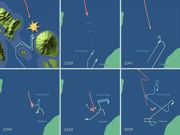
The track charts below show the battle plan, the approach and the progress of the battle and a summary.




By August 1943, the problems with American torpedoes had at last been acknowledged and solutions identified. On the 3rd, Comdr. Frederick Moosbrugger relieved Comdr. Burke as commander of Task Group 31.2, a destroyer “striking force” under Amphibious Force Commander RAdm. Theodore Wilkinson.
On 5 August, Adm. Wilkinson ordered Comdr. Moosbrugger to depart his base at Purvis Bay near Guadalcanal the following night and sweep Vella Gulf with two destroyer divisions: his own DesDiv 12 flagship Dunlap plus Craven and Maury as “Division A-1” and DesDiv 15 Comdr. Rodger Simpson’s flagship Lang with Sterett and Stack as “Division A-2.”
Moosbrugger prepared a well-conceived, clearly written plan of action and reviewed it at a conference of his commanding officers on the morning of the 6th, achieving complete mutual understanding of all possibilities. They then took departure and shaped a course not up the “Slot,” the central channel through the Solomons where they might be readily detected, but via a southern route to approach Vella Gulf through Gizo Strait. Their priority: attack any enemy destroyers and cruisers encountered.
In Vella Gulf shortly before midnight, with the two divisions in formation 4,000 yards apart, they probed Blackett Strait; then turned north along the Kolombangara coast. Soon, radar contact was made with four Japanese destroyers carrying reinforcements for Kolombangara and closing on a course for Blackett Strait at a relative speed of nearly 50 knots. Less than ten minutes later, Division A-1 had maneuvered into position—exactly as planned—and fired 24 torpedoes. As it turned away to evade any Japanese response, Division A-2 crossed ahead of the oncoming Japanese formation to attack from a new direction.
After what seemed like an eternity, Division A-1’s torpedoes hit all four Japanese ships, blasting the first three and holing the rudder of the fourth. Division A-2 promptly opened gun and torpedo fire, completing the destruction of the three destroyers while the fourth, unseen, got away. The two divisions lingered, trying to pick up survivors but they refused rescue; Division A-2 then followed Division A-1 in retiring down the Slot, having sustained no damage or casualties.
The Battle of Vella Gulf, the U.S. Navy’s first independent destroyer action in the South Pacific, marked a turning point in American surface warfare. Coming a full year after the Guadalcanal landing, it showed that our weapons worked, that our doctrine was sound and that a surprise torpedo attack—delivered by destroyers as the primary attack unit—could be devastating to the enemy.